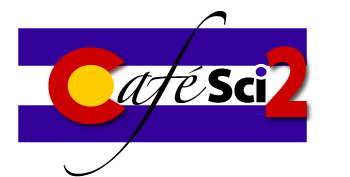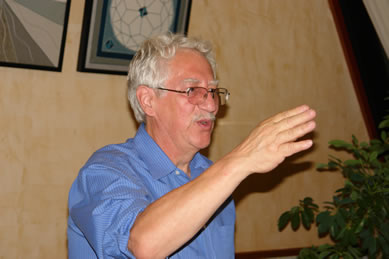|
For seven years of his career, Russ was director of NOAA’s Mauna Loa Observatory, Hawaii, where the steady global increase in carbon dioxide, that forms the backbone of the greenhouse gas atmospheric warming hypothesis, was established. Changes in the make-up of the atmosphere – bringing inevitable changes in the Earth’s climate – are the main subject of Dr. Schnell’s talk. And he should know about these changes: he serves as Deputy Director for the NOAA laboratory that carefully and continuously collects and analyzes air samples from all over the world to determine how the atmosphere is changing – and at what rate. He is conversant on what we know about climate change, what is forcing it, and what we don’t know and are working today to figure out. Early in his career, Dr. Schnell discovered biological ice nuclei that are now used in snowmaking at ski hills around the world, and by their removal on plant leaves, prevention of frost damage in living crops to temperatures as cold as -3C. His later research established that Arctic Haze was air pollution from Eastern Europe. He has published papers on carbon dioxide, black carbon, ozone production and destruction in the Arctic and Antarctic, on global transport of dust and air pollution, and on the changing chemical composition of the atmosphere. Overall, he has published 125 scientific papers, eight of them in Nature. He holds patents in plant science, biochemistry and biology. In 2007, Dr. Schnell was recognized as one of the NOAA contributors to the IPCC Intergovernmental Panel on Climate Change (IPCC) report that was a co-recipient of the 2007 Nobel Peace Prize. In 2008, he was awarded the U.S. Department of Commerce Silver Medal the highest honorary recognition the Department bestows, for helping develop the Annual Greenhouse Gas Index that quantifies the annual increase in atmospheric heating from greenhouse gases. |
|
Russ Schnell points out that there's not much air. That is, compared with the size of the globe, the atmosphere is thin. So it does not take much in the way of chemical changes to affect the atmosphere very dramatically. What humans put into the air has a big impact on our atmosphere. NOAA has deployed five atmospheric observatories across the Pacific region to monitor Earth's air. They each take 300 to 400 different types of measurements daily. Of the one on Mauna Loa, Russ says "The air that comes there is well mixed, meaning that it doesn't have any local pollution. So it's kind of the background, the purest, the most stable air you can measure." The stable background helps in monitoring the global changes happening in our atmosphere. Long-term data from the observatories show that carbon dioxide concentrations – now known to be responsible for driving climate change – are increasing. Schnell added that if countries set requirements to cut carbon dioxide emissions, these observatories would be able to detect any net effect on the atmosphere. "We'll be able to tell if in fact the U.S. is able to cut down CO2 production, if China is, or if they're increasing." The atmospheric observatories he oversees provide baseline data. Their data must serve as a reliable comparison to data over other times, or places. "The idea of an observatory is that the measurements you made in 1960 should be exactly comparable to the ones you make in 2060. Over 100 years, you want to be sure that your measurements are not changing so that any changes you see are the atmosphere. We calibrate instruments constantly, sometimes two or three times a day. You calibrate it with standards, some of which are 50 years old. A lot of the work is making sure the equipment is working and putting out data that's valuable, and valid, and will be valid for many, many years. He said that collecting information about the atmosphere by measuring the contents of the air is like collecting information about people from the garbage they throw out. " If I went to your apartment every week and collected your garbage, and you didn't know that I was collecting your garbage, I would take it to a warehouse and lay it all out and study it. I would get it next week, and then next week. After a period of about 2 or 3 years, I would know an awful lot about you and your health, your financial situation, and whatever, by looking at what you throw away. That's what happens with cars. We drive, we throw CO2 and other gases out the tailpipe. We discard a refrigerator and the chemicals leak. Power plants put out materials all the time. All this stuff goes into the atmosphere. It doesn't disappear. It goes mixing around. We look at that and study the changes and correlations between the changes. We start understanding where the atmosphere is changing, how it's changing, and where the sources for these changes are." Thanks to Earthsky.org for most of this background. Resources:Education and Outreach sites at NOAA |

 Dr. Russ Schnell is Deputy Director of the Global Monitoring Division, Earth System Research Lab, at the National Oceanic and Atmospheric Administration (NOAA) in Boulder. Like the atmosphere he studies and publishes well-cited papers about, Russ Schnell is nearly everywhere. Born in Canada, Dr. Schnell has lived, traveled or worked in 88 countries, and on every continent. Just in the past half year, he has represented NOAA’s atmospheric sciences in Germany, Azerbaijan, Switzerland, Mexico and Hawaii.
Dr. Russ Schnell is Deputy Director of the Global Monitoring Division, Earth System Research Lab, at the National Oceanic and Atmospheric Administration (NOAA) in Boulder. Like the atmosphere he studies and publishes well-cited papers about, Russ Schnell is nearly everywhere. Born in Canada, Dr. Schnell has lived, traveled or worked in 88 countries, and on every continent. Just in the past half year, he has represented NOAA’s atmospheric sciences in Germany, Azerbaijan, Switzerland, Mexico and Hawaii.